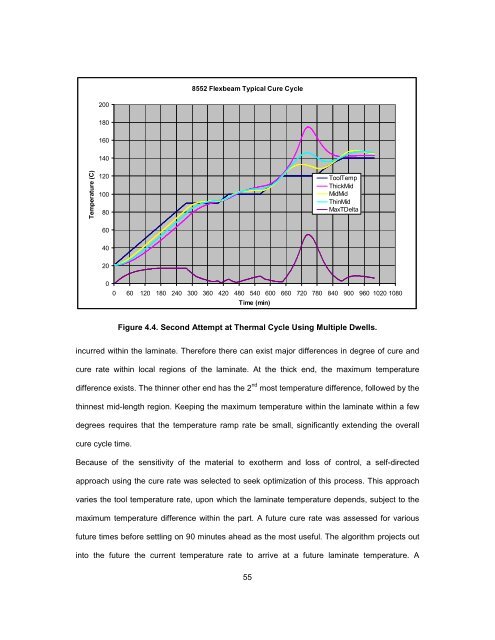TOOLED THICK COMPOSITES by ARVEN H. SAUNDERS III ...
TOOLED THICK COMPOSITES by ARVEN H. SAUNDERS III ...
TOOLED THICK COMPOSITES by ARVEN H. SAUNDERS III ...
You also want an ePaper? Increase the reach of your titles
YUMPU automatically turns print PDFs into web optimized ePapers that Google loves.
Temperature (C)<br />
200<br />
180<br />
160<br />
140<br />
120<br />
100<br />
80<br />
60<br />
40<br />
20<br />
0<br />
8552 Flexbeam Typical Cure Cycle<br />
0 60 120 180 240 300 360 420 480 540 600 660 720 780 840 900 960 1020 1080<br />
Time (min)<br />
55<br />
ToolTemp<br />
ThickMid<br />
MidMid<br />
ThinMid<br />
MaxTDelta<br />
Figure 4.4. Second Attempt at Thermal Cycle Using Multiple Dwells.<br />
incurred within the laminate. Therefore there can exist major differences in degree of cure and<br />
cure rate within local regions of the laminate. At the thick end, the maximum temperature<br />
difference exists. The thinner other end has the 2 nd most temperature difference, followed <strong>by</strong> the<br />
thinnest mid-length region. Keeping the maximum temperature within the laminate within a few<br />
degrees requires that the temperature ramp rate be small, significantly extending the overall<br />
cure cycle time.<br />
Because of the sensitivity of the material to exotherm and loss of control, a self-directed<br />
approach using the cure rate was selected to seek optimization of this process. This approach<br />
varies the tool temperature rate, upon which the laminate temperature depends, subject to the<br />
maximum temperature difference within the part. A future cure rate was assessed for various<br />
future times before settling on 90 minutes ahead as the most useful. The algorithm projects out<br />
into the future the current temperature rate to arrive at a future laminate temperature. A
















